by King's Nursery | May 17, 2025 | Front Page News, General
 It’s the best time for gardenias- the flowers are loving this weather….
It’s the best time for gardenias- the flowers are loving this weather….
I’ve always thought of the gardenia as the southern belle in my garden, loving the warm nights and summer heat so prevalent in the south. Visions of a flower-filled courtyard in the moonlight, a heady fragrance in the evening air. A lovely lady wearing one in her hair. A gentleman’s boutonniere.
These glossy evergreen shrubs are happy to grow here in our climate. A few things about gardenias worth mention:
-Get the grafted ones. They were originally developed for nematode resistance in the southern states, but it was discovered that grafted plants will utilize nutrients more efficiently, making them greener, more floriferous and vigorous.
– Food. Give them acid fertilizer monthly during the growing season from March – October, and you will be rewarded with many more flowers. (We use and recommend Master Nursery Gardenia food). You can also use a water-soluble fertilizer like Maxsea Acid Liquid food every 2 weeks. Additionally, it is worth-while adding in some granular Iron or liquid Chelated Iron. These help maintain acidity, while also supplying additional micro nutrients.
– Plant them with Master Nursery Eureka Planting Mix. It has great drainage and some acidity right out of the bag. Use it straight in containers, or mixed in with your native soil in the ground. While you’re at it, throw in your first dose of fertilizer.
-Flowers are most prolific when the nights are warm, so pick a nice warm spot. I like to put them near a walkway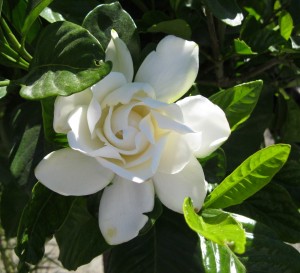 or window to best enjoy the wonderful fragrance. And yes, I bring the flowers inside- how could you not?
or window to best enjoy the wonderful fragrance. And yes, I bring the flowers inside- how could you not?
We like to stock these plants most of the year, but now is the best time to plant them. Once the blooms open, and you smell those flowers….come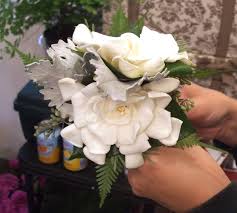 on by to see what I mean. Our staff is ready to tell you more if you have any questions.
on by to see what I mean. Our staff is ready to tell you more if you have any questions.
by King's Nursery | Feb 27, 2025 | Front Page News, General

‘Eureka’ lemon tree loaded with fruit
I’ve been collecting citrus trees in my garden these last few years, and I have to admit I’m hooked!
Along with fresh herbs, citrus fruit has become a staple at my house. I keep a large bowl on the table, with lemons, limes, oranges and the occasional grapefruit inevitably outnumbering the other seasonal offerings. Salads, drinks, cooking and baking can always use some fresh juice or zest, and I absolutely relish a good batch of lemon curd now and then…
You can have all kinds citrus in your garden, too. They’re fairly easy to grow, and there are so many different kinds that do well here. The flowers smell phenomenal, plus the ornamental value of glossy, evergreen leaves against the lush display of fruit is hard to beat.
Planting in containers is just fine (especially with semi-dwarf varieties, since they only top out between 8-12′). You can even graduate in container size as you go, as long as you end up in something about the size of a 1/2 wine barrel. Use Master Pride Potting Soil, or Recipe 420 Potting Soil, along with a nice starter fertilizer (like Master Start or Sure Start). In-ground plantings get started off right when you add plenty of rich Paydirt into the native soil, along with the fertilizer. For happy, productive plants, fertilize regularly (typically each month or so) with E.B Stone or Master Nursery Citrus Food . 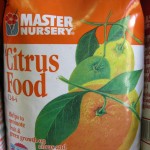

Home grown ‘Washington Navel’ oranges
We carry lots of citrus all through the year, and we make sure to grow the unusual varieties as well as the favorites. Here are a few of the coolest:

Meyer lemons are the tastiest!
‘Meyer’ lemon– there’s a reason these are so popular; just one taste will tell you why. Full flavored, with a delightful balance between tart and sweet. Ultra productive, too, with year-round fruiting.
‘Bearss’ (or Persian) lime– Bigger, juicier, and more flavorful than the kind you’d find at the store, and I must say, this is the tastiest lime I’ve ever tried. Grows better in Sonoma County than any other lime.
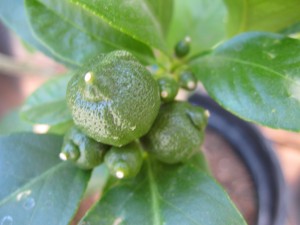
young limes
‘Owari Satsuma’ mandarin- hardy and vigorous, with a bushier appearance than other citrus. Plentiful, snack-sized fruit.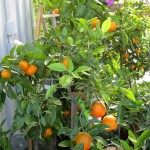
For something different, try a few on the more exotic side:
‘Variegated Pink’ lemon– Clear/ pink flesh inside of green & yellow striped rind, with nice acidity. The foliage is downright gorgeous, with bold cream-colored splashes and bright pink new leaves.
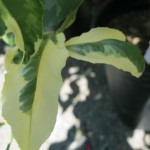
variegated pink lemon leaves
‘Kieffer’ lime– the leaves are used in Asian cooking, as are the small bumpy limes. Deep purple-red new growth adds visual contrast amongst the green fruit.
Kumquat– Smaller than other citrus, Kumquats are unique in that the whole fruit is eaten; peel and all! Flavors range from tart to semi-sweet.
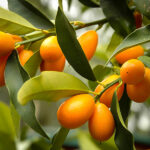
Nagami Kumquat
You can plant any of these (and many more) right now, so come in and see our selection- there’s a lot to choose from!
by King's Nursery | Nov 6, 2023 | Front Page News, General
It’s that time of year- fragrant Daphne are here!
We have lots of these old-fashioned beauties in stock right now!
I can’t get enough of the potently fragrant flower clusters, reminiscent of citrus blooms. Mmmmm- heavenly! I cut new bouquets every few days, putting them where the scent can be enjoyed the most. I’ll even bring some along when I go to visit friends and neighbors- perfect little hostess gifts.
Plant it in a spot that gets partial sun. Use Master Nursery Planting Mix straight out of the bag for containers, or mix it 50/50 with the native soil back into the hole. Don’t forget the Masterstart- it gets those roots growing quick.
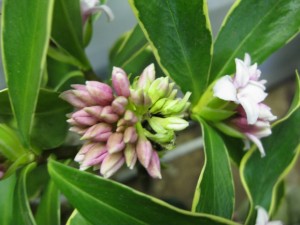 There are more reasons to love this old-fashioned beauty than just the flowers:
There are more reasons to love this old-fashioned beauty than just the flowers:
Deer resistance. This is one plant that is reliably impervious to deer, regardless of where you live. Yay! No fences or sprays needed!
Drought tolerance. Not only is daphne tolerant of drought, but it prefers low water (especially in the summer months). Wow, no problem- I like to keep that water bill down.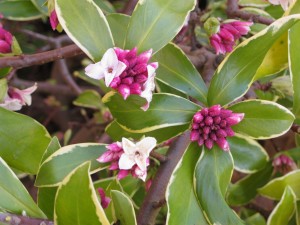
Evergreen. The glossy leaves are showy on their own, true green with nicely contrasting cream margins. Each leaf is somewhat different than the next, so you’ll see variations in the pattern of color. It really pops next to deeper tones- I have it against a dark wooden fence.
Daphne is a moderate grower, topping out at about 4’X4′ over time. It does well in a fair amount of shade, but also in a fair amount of sun, so where you plant will perhaps depend more on daphne’s water needs than the sun exposure. I have mine planted beside my front walkway, to best enjoy the delicious fragrance.
We have a great selection of nice and healthy daphne plants right now, so stop by.

Hello, Gorgeous!
by King's Nursery | Sep 8, 2019 | Front Page News, General
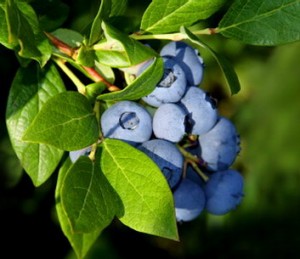
Ready for picking
It’s berry time, and we’ve got a nice crop of plants that will be so LOADED with berries next spring that you will barely see the leaves! They will give a harvest that first season and fruit will be produced for months, so they’re gonna give you you’re money’s worth right away.
Why we love blueberries-
Blueberries are an excellent and permanent addition to edible and ornamental landscapes because, thanks to modern breeding, they are very easy to grow. The handsome plants have dark blue-green foliage and attractive pink or white ‘ bell’ blooms in spring, which turn into yummy blue summer berries.
Some even have great autumn color, with a full spectrum of yellow, orange and red. All can be planted in the veggie garden or used in the landscape. All this and the bonus of luscious fruit loaded with anti-oxidants! Since they are a permanent addition to the garden, the yields of berries increase each year.
Planting
In our fabulous gardening climate, blueberries can be planted most anywhere from full sun to part sun. Just be sure the location gets at least a half a day of good sunlight. Since they are long lived, it is a wise idea to amend the soil properly when planting. A wide, fairly shallow planting hole, backfilled with half Master Nursery Planting Mix and half our native soil along with a dollop of Master Start fertilizer would be great. After planting, mulch with a bit of additional Planting Mix to help with moisture retention. Planting distance can be up to 5 feet apart or as close as 3 feet for a hedge effect. Or, intersperse them throughout the garden. Blueberries easily adapt to containers and to make it even easier, you can use Master Nursery Planting Mix straight from the bag. You could even add flowers and herbs to the container for a beautiful effect.
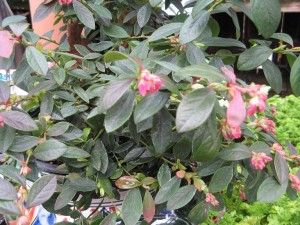
Blueberries are ornamental, too
Care
It’s so easy! The new blueberries are low maintenance, vigorous plants. They like routine water like your other garden plants and monthly feeding  March through October with our Camellia Azalea food or our veggie food. Your berries will produce more and bigger fruit with a bit of winter pruning. First remove any dead wood, then thin out about a third of what remains. As the plant grows older, you can select six or so main erect branches to form its permanent structure.
March through October with our Camellia Azalea food or our veggie food. Your berries will produce more and bigger fruit with a bit of winter pruning. First remove any dead wood, then thin out about a third of what remains. As the plant grows older, you can select six or so main erect branches to form its permanent structure.
Selection
We select and prefer the southern highbush varieties as they are particularly suitable for our Sonoma County climate. They love the warm days as well as the cool ones and thrive in our mild winters. Three plants are about the minimum for a family but there are, of course, no limits. Blueberries are self pollinating. So, if you remember 7th grade science, that means you only need one plant to get some fruit. However, the more the merrier in the world of the birds and bees. In fact, the fruit will be much more prolific if you plant two or more varieties. Also, by mixing varieties you can easily extend your harvest. Some of our favorites (but we love them all)…
Jubilee: Fruits early, nice and upright
Misty: Fruits very early with lots of berries
O’Neal: Another very early variety
Sharpblue: Fruits early to mid season and great to extend the season. Fast grower with big berries.
Star: Fruits early with large berries
Sunshine Blue: Mid season, a more compact plant and evergreen.
Plus others, of course, and please feel free to ask us any questions about blueberries or other parts of your garden. At least in the garden, we want you happy, healthy and successful.
by King's Nursery | Sep 2, 2019 | Front Page News, General
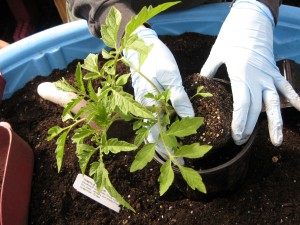 It’s a wonderful, magical time of year- cool season vegetable planting time!
It’s a wonderful, magical time of year- cool season vegetable planting time!
Oh my, veggies and other edibles are certainly the thing right now. People really want to grow their own food, and they’re so excited to plant anything and everything……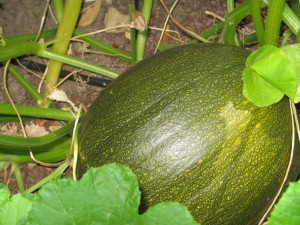
Thinking of growing cool season vegetable plants, from seed or starts? We carry both! High quality seeds that are guaranteed to grow, and eager young starter plants that are locally grown. Yes! And food can be grown year-round here in Sonoma County, and you can even incorporate edibles into your ornamental landscape (this trend is called ‘ornamedibles’)
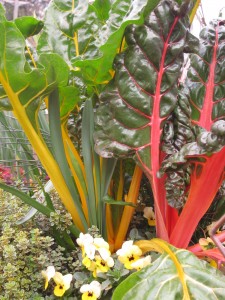 Since more gardeners have decided they like heirloom and unusual veggies and herbs, we like to offer cool season stuff you don’t see anywhere else, like ‘Cheddar’ cauliflower, purple broccoli, or kallettes.
Since more gardeners have decided they like heirloom and unusual veggies and herbs, we like to offer cool season stuff you don’t see anywhere else, like ‘Cheddar’ cauliflower, purple broccoli, or kallettes.
Some folks are devoted to reliable stalwarts in the veggie garden. If you are the type who relies on the tried and true, you’ll find the great fall and winter classics here- ‘Snowball’ cauliflower, romaine lettuce, sugar snap peas, etc.

It’s wise to add compost and get the soil ready to embrace the new additions you’ll soon be tending. We LOVE Paydirt, a stinky organic compost made from chicken manure and mushroom compost. An easy way to add this in is to put a 3-6″ layer over your plot, then rototill as usual. Or, if your not tilling, just ‘double dig’ the compost into each planting hole, leaving the rest of the compost layer undisturbed; it will act as a mulch, keeping weeds out and moisture in (every bit counts!)

Feed Me!
Did you know how much of a difference it makes when you fertilize your veggie garden? If you want the most produce you can grow, throw out some granular veggie food, like Master Nursery Tomato vegetable food or E.B.Stone organic tomato vegetable food. I noticed a big increase in the amounts that were harvested through the season when I fertilized once a month, and it hardly took any time at all. I just scattered the food around the root zone of all my herbs and veggies, then watered it in- done!
Until recently, eliminating slugs and snails from my tender seedlings would require the application of highly toxic snail bait. Now there’s Sluggo- iron phosphate, which is safe for humans, pets and wildlife. This product is perfect for the veggie garden, it’s organic, and any unconsumed pellets even break down into nutrients that feed your plants. How do they come up with this stuff?
Plant most crops in the full sun, or at least 6 hours of afternoon sun, to get your plants to produce well. Certain types of veggies like as much heat as possible, like peppers and melons, while other things can accept partial sun, like strawberries, lettuces and basil.
Remember, King’s is a great resource to help you along the veggie garden path. We will answer any questions, offer growing tips and advice, demonstrate and explain what you can do to have a successful harvest- just come on in!
 It’s the best time for gardenias- the flowers are loving this weather….
It’s the best time for gardenias- the flowers are loving this weather….

 or window to best enjoy the wonderful fragrance. And yes, I bring the flowers inside- how could you not?
or window to best enjoy the wonderful fragrance. And yes, I bring the flowers inside- how could you not? on by to see what I mean. Our staff is ready to tell you more if you have any questions.
on by to see what I mean. Our staff is ready to tell you more if you have any questions.


















